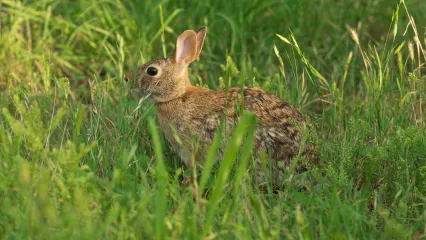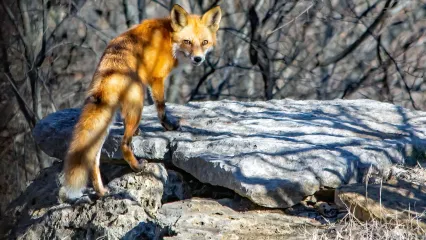
Description
Whether it is pursued behind a pack of beagles or it is encountered on some early morning in your own backyard, the Eastern cottontail rabbit (Sylvilagus floridanus) is one of Oklahoma's most well known and beloved wildlife species. They can be found from southern Canada to South America, predominantly east of the Rocky Mountains.
It has soft brown hair and a white underbelly, a well as its namesake cotton ball-like tail. Similar to the whitetail deer, the cottontail will raise its tail like a warning flag when fleeing danger.
A cottontail will eat just about anything green, but use the most nutritious foods first, such as legumes clover and young forbs. A young rabbit will consume large amounts of grass and weed like dandelions and ragweed. During the winter, when its normal food sources are scarce, rabbits will resort to eating shrubs and tree buds. Rabbits are most active during the early morning and late evening hours.
Cottontails are one of the primary links of the food chain and wherever they are found serve as essential prey for predators. Young rabbits in particular are an important food source for a variety of species from coyotes to red-tailed hawks As a result of this predation, a cottontail that lives more than a year is the minority. However the rabbit is not a helpless victim, it can jump distances of up to eight feet at a time and can make lightning quick changes in direction to elude predators.
Cottontail rabbits have historically been an important game animal in Oklahoma. Their prolific numbers have provided generations of hunters with hours of sport and countless meals of tender rabbit.
Whether in a windswept prairie or quiet suburban yard, the cottontail rabbit will continue to be one of the state's most popular wildlife species.
Size
Mostly ears and legs, an adult cottontail measures about 16 inches and weighs between two and three pounds.
Habitat
Cottontails can be found in a variety habitats, but are most abundant in open country. Rabbits will most often be found anywhere two types of cover meet, such as fence rows, or in tangled thickets in pastures or along roadsides. Rabbits also show a preference to areas not far from a water source whether it be pond creek or spring. Cottontails rely on shrubs or woody vegetation for escape cover. Just like Briar Rabbit. the denser and thornier the cover is the better the rabbit likes it. A rabbit's home range varies depending on the quality of habitat. On average. a female cottontail's home range Is five to 15 acres, while the male's may be as much as 100 acres.
Life Cycle
The cottontail rabbit has been huge success in adapting to man's manipulations of the environment. When homesteaders first came to this state rabbits found new garden buffets, and as subdivisions now go up in our metropolitan areas, rabbits find remaining niches of cover to raise their young.
Cottontails begin to court as early as February. A litter of four to seven bunnies is born after a gestation period of 27 days. The mother rabbit feeds her young milk twice a day at dawn and dusk. To protect the helpless, hairless bunnies from the cold the mother builds a nest from surrounding vegetation and the soft fur from her belly. She covers the young in the nest to keep them warm and dry when she goes out to feed.
The young rabbits grow very fast, and after only a week, the bunnies have fur, and their eyes and ears are open. After two weeks, the bunnies take their first hops away from the nest and a few days later they leave the nest to fend for themselves.
Rabbits are quite prolific and may produce multiple litters in a year; with good weather and habitat a female rabbit may produce six litters in a single year.


